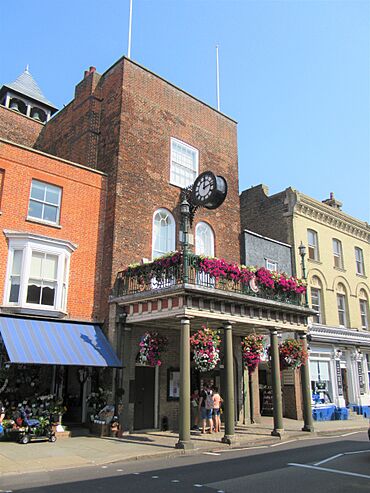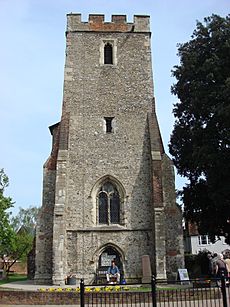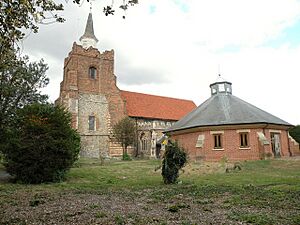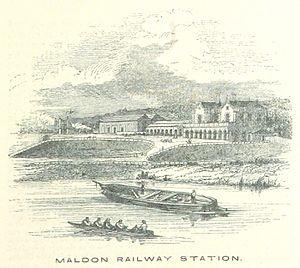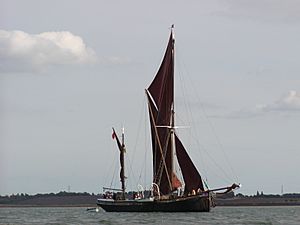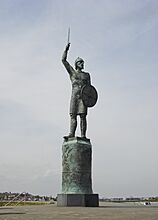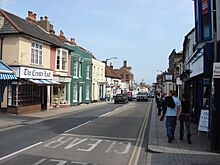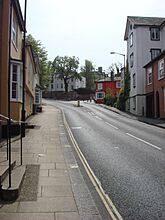Maldon facts for kids
Quick facts for kids Maldon |
|
|---|---|
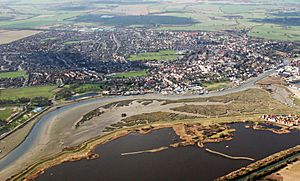 Maldon viewed from the north east |
|
| Population | 14,941 (2021 Census) |
| OS grid reference | TL848070 |
| Civil parish |
|
| District |
|
| Shire county | |
| Region | |
| Country | England |
| Sovereign state | United Kingdom |
| Post town | MALDON |
| Postcode district | CM9 |
| Dialling code | 01621 |
| Police | Essex |
| Fire | Essex |
| Ambulance | East of England |
| EU Parliament | East of England |
| UK Parliament |
|
Maldon (/ˈmɔːldən/, locally /ˈmɒldən/) is a historic town in Essex, England. It sits right by the Blackwater estuary. Maldon is the main town of the Maldon District. It's also famous for its special Maldon Sea Salt. In 2011, about 14,220 people lived in the town.
Contents
History of Maldon
Early Times and Middle Ages
The name Maldon was first written down in 913 in the Anglo-Saxon Chronicle. It was called Maeldun back then. The name means 'monument hill', from old words for 'monument or cross' and 'hill'.
People called East Saxons settled here in the 5th century. Maldon became an important Saxon port. It had a special quayside for boats and areas where skilled workers lived. Old pottery found by archaeologists shows that goods were brought in from other places. From 958, Maldon even had a royal mint where coins were made for kings.
Maldon was one of only two towns in Essex at that time. King Edward the Elder might have lived here while fighting the Danish settlers. In 924, a Viking attack was stopped. But in 991, another Viking raid led to the famous Battle of Maldon. The Saxon defenders lost, and the Vikings were paid a special tax called Danegeld. This battle is remembered in an old poem called "The Battle of Maldon". You can see a window in St Mary's Church and a statue of the Saxon warrior Byrhtnoth near the river to remember the battle.
In 1086, the Domesday Book said Maldon had 54 homes and about 180 townsmen. The town still had its mint and provided a warhorse and warship for the king. In return, it had special rights to govern itself. King Henry II gave Maldon a special document called a charter in 1171. This paper set out the town's rights and its duty to provide a ship for the king.
Maldon's All Saints' Church is special because it has a triangular tower. It was built around the same time, before 1180. St Mary's Church, by the Hythe Quay, has parts from 1130. The Maldon Moot Hall was built around 1420.
Later History
Maldon had strong traditions, like electing two members to Parliament. It also had three guilds that put on big religious plays. These plays were stopped by Puritans in 1576. Later, professional actors performed plays until 1630, when Puritans stopped them too.
In the 17th century, Thomas Plume started the Plume Library. It holds over 8,000 old books and papers from 1487 onwards. The library is in St Peter's Church. Only the church's original tower is left. The rest was rebuilt by Thomas Plume to hold his library upstairs and Maldon Grammar School downstairs.
All Saints' Church has a special window for George Washington. His great-great grandfather, Lawrence Washington, is buried there. An American diplomat showed the window in 1928. It shows Saint Nicholas, the Mayflower ship, Saint George, and Saint Joan of Arc. It also has the Washington family's coat of arms and symbols for the USA, England, Scotland, and Wales. At the bottom, you can see pictures of George Washington and the Statue of Liberty.
Maldon also has several other churches and a mosque. During World War II, Maldon was part of Germany's plan to invade Britain, called Operation Sea Lion.
Maldon's Location and Land
Maldon is located on the River Chelmer, which flows into the Blackwater Estuary. It is about 10 miles (16 km) east of Chelmsford. London is about 49 miles (79 km) to the north-east.
The land in Essex is mostly made of London Clay. There are also areas with gravel left by rivers. The lowest parts are made of river mud and salt marsh. Maldon has some interesting land formations called landslips along the river.
Hythe Quay, where the Chelmer and Blackwater rivers meet, was once a very important port. Cooks Yard is still there and is known for its Thames sailing barges. The River Blackwater flows into the Blackwater Estuary through locks at Heybridge Basin.
Getting Around Maldon
Trains
Maldon used to have two railway lines. Today, the closest train stations are Hatfield Peverel, Witham, and North Fambridge.
Maldon's first train line opened in 1846 and went to Witham. Later, a second line connected Maldon to Woodham Ferrers. This line joined the Crouch Valley line. The line between Maldon and South Woodham Ferrers closed for passengers in 1939. The line between Maldon and Witham closed in 1966.
Buses
You can get around Maldon and nearby areas using regular bus services. The main bus companies are First Essex and Hedingham. Key routes connect Maldon to Chelmsford, Colchester, and Witham.
What Maldon Makes and Does
Maldon Sea Salt has been made in the town since 1882 by the Maldon Crystal Salt Company. Maldon was also home to the first Tesco "supermarket" in the country, which opened in 1958.
Maldon's Hythe Quay is where many Thames sailing barges are kept. These are some of the last cargo ships in the world that still use sails! Today, they are used for teaching and fun. Many of these barges call Maldon their home port. An annual sailing barge race finishes at the quay with a parade and prize-giving. Cooks Yard, where barges were once built, is still working at the end of Maldon Quay.
Fun Things in Maldon
Maldon holds a special event called the Maldon mud race. People race across the Blackwater estuary at low tide, through the mud and water. This race raises a lot of money for charities. Maldon also hosts the international Maldon Festival every year in late June and July.
The town has an annual "Taxi Day." On this day, children with disabilities from London are driven to Maldon in London Black Cabs. They have a fun day of activities and a meal. This event started in 1952. Maldon was the only town willing to help a London cab driver arrange an outing for these children.
Maldon is also twinned with the Dutch town of Cuijk. This means they are like sister towns and have a special friendship.
Media in Maldon
You can get local news and TV shows from BBC East and ITV Anglia. Local radio stations include BBC Essex, Heart East, Radio Essex, Greatest Hits Radio East, and Caroline Community Radio. The local newspaper for the town is the Maldon and Burnham Standard.
Sports in Maldon
Maldon has a football club called Maldon & Tiptree F.C.. There are also many youth football teams like Maldon Saints. The town has a lively cricket club with several teams for adults and young players. They play at two grounds, including Drapers Farm in Heybridge. Drapers Farm is also home to Maldon Rugby Union Football Club, which started in 1947. They have many teams for different age groups.
The Blackwater Leisure Centre is the town's main place for sports and fitness. It has a swimming pool, a gym, and a sports hall. There were also short-lived greyhound racing tracks in Maldon in the 1930s.
Famous People from Maldon
Sir Alastair Cook (born 1984), a famous Essex and England cricketer, played for Maldon Cricket Club when he was young. He is still connected to the club and is a role model for young players.
Singer/songwriter and TikTok star Sam Ryder (born 1989) is from Maldon. He represented the UK in the Eurovision Song Contest 2022 with his song "Space Man" and came in 2nd place.
Private David Embleton (1853–1912), known as Frederick Corbett in the army, won a Victoria Cross for bravery in Egypt in 1882. He is buried in Maldon.
Edward Bright (1721–1750) was known as the "fat man of Maldon." He was a grocer who weighed about 47.5 stone (about 300 kg). His coat was so big it could fit seven men! His chair is still in Maldon Moot Hall.
John Kemp (1926–1987) helped save the Thames sailing barges in the 1960s. He helped make Maldon the most important sailing barge port in the country. He also wrote books about Maldon and the people who lived by the marshes.
Myra Sadd Brown (1872–1938) was born in Maldon. She was a Suffragette who fought for women's rights.
John Strutt (1842–1919) was a British mathematician and scientist born near Maldon. He won the Nobel Prize in Physics in 1904 for helping to discover the gas argon.
Horatio Gates (1727–1806), an English general who fought in the French and Indian War and later for the American side in the War of American Independence, was born in Maldon.
Ethan Lawrence (born 1992) is an English actor from Maldon. He is known for his roles in the BBC series Bad Education and the Netflix show After Life.
Twin towns
Maldon is twinned with:
- Villeparisis, Île-de-France, France
- Cuijk, North Brabant, Netherlands
Gallery
-
Byrhtnoth statue marking the Battle of Maldon in 991, in which Byrhtnoth died
Nearby places
- Beeleigh Abbey
- Brightlingsea
- Burnham-on-Crouch
- Chelmsford
- Danbury
- Great Totham
- Hazeleigh
- Heybridge
- Langford
- Little Totham
- Maylandsea
- Mundon
- North Fambridge
- South Woodham Ferrers
- Steeple
- Tiptree
- Tollesbury
- Tolleshunt Major
- Tolleshunt Knights
- Tillingham
- Cold Norton
- Witham
- Woodham Mortimer
- Woodham Walter
See also
 In Spanish: Maldon para niños
In Spanish: Maldon para niños



